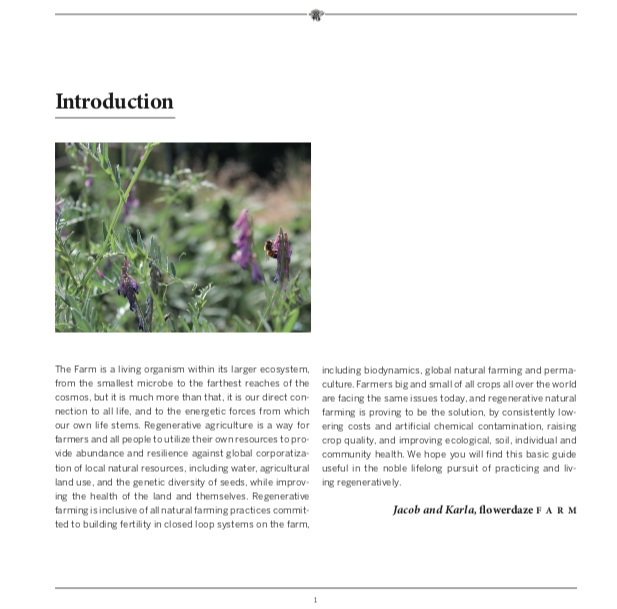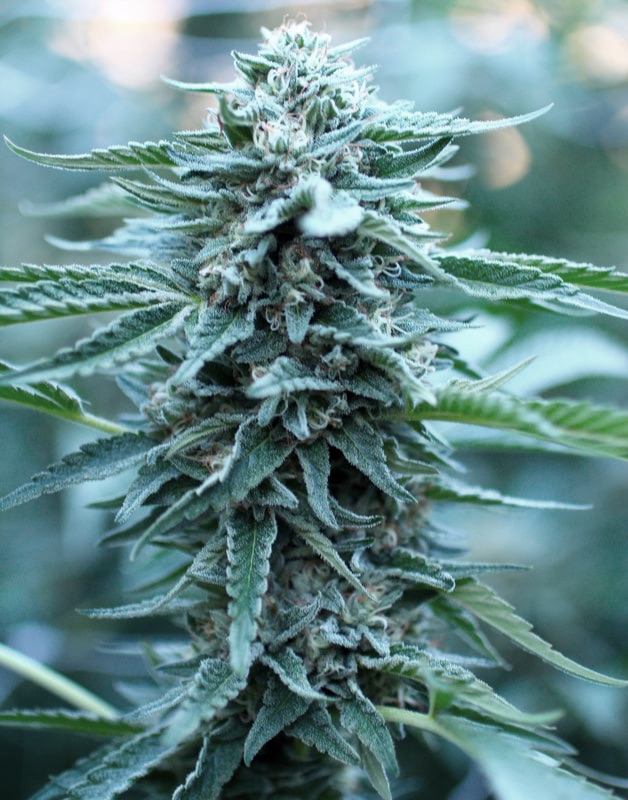|
CLICK HERE TO ORDER The Flowerdaze Farm Regenerative Guide to Cannabis Want to know how we grow award-winning flowers using only homemade, farm-sourced inputs? This is an easy-to-use basic guide to our season-long recipe for cultivating the dankest, highest quality cannabis, using only natural, farm-sourced, homegrown and homemade ingredients. For all beyond-organic gardeners, these fertility methods can be utilized on any scale from home grows to craft commercial farms. Reviews "Cannabis farmers have the ultimate responsibility of working with the plant that has the potential to clean the planet through its phytoremediation abilities while transforming the health of humanity. Thankfully we have role models and teachers like Jacob and Karla to guide us on this path. This little gem of a book is straightforward and packed with clear instructions on how to transform your gardening using time-tested biodynamic and regenerative farming techniques." -Frenchy Cannoli, Master Hashishin "Flowerdaze Farm's regenerative and biodynamic cultivation methods produce exceptionally dank flowers. Generously sharing their time-tested recipes and techniques, they've made it possible for any gardener to grow cannabis of a superior quality that is sure to stand out in a market full of mids." -Caitlin Podiak, Certified Dank "Thank you Flowerdaze Farm for taking the time to transform your expertise into DIY information for all. We look forward to supporting communities everywhere in their transition toward regenerative agriculture." -Hollie and Dan, Compliant Farms Certified "I've been seeking the wisdom of how to deeply connect with cannabis and our land. This guide from Flowerdaze Farm showed me the truth, love, and how to move forward with transitioning into a regenerative farm." -Sassy from Booney Acres CLICK HERE TO ORDER YOUR PRINTED COPY Also available in Ebook. Look for The Flowerdaze Farm Regenerative Guide to Cannabis Ebook at most major Online Retailers
0 Comments
Historically, the “Top Shelf” at most retail dispensaries has been largely and almost exclusively indoor grown. There is no question that an indoor cultivator with great skill can create a product that looks just right, and is harvested at the exact finishing time. In fact every watering, feeding and light cycle can be perfectly timed out with a timer, often controlled entirely from the grower’s mobile device while they are somewhere else besides their grow room. However, it is our opinion that the sun is still better than any light bulb, and that full season naturally sungrown flowers have the most optimal terpene, cannabinoid, and flavonoid profiles.  Our Full Season Sungrown Strawberry Cough, now available at Solful cannabis dispensary in Sonoma County, CA Our Full Season Sungrown Strawberry Cough, now available at Solful cannabis dispensary in Sonoma County, CA Truth be told, really great growers committed to their craft from start to finish grow really great weed, indoors or outdoors. However, it is harder to be Regenerative, to go way beyond sustainable, when you are not using the sun or growing in nature, and consumers should and do care about how their product is made. And yes, we will admit, we do think that all other aspects being equal, a flower sungrown in nature is a superior product. Like any great work of art, the closer it is to truly divine inspiration, the greater the masterpiece; there is a certain undeniable magic to the spiritual and connective experience of a medicinal plant grown in this artisanal and regenerative way, with great love and attention in complete harmony with nature and the cosmic vibration of all existence.  Strawberry Cough growing in poly-culture alongside Tomatillos in the garden Strawberry Cough growing in poly-culture alongside Tomatillos in the garden Unfortunately, the reality still remains that the small farmer faces the steepest part yet of the climb in the arduous road to the California retail market. Only 1% of the existing heritage farmers in the three counties of the Emerald Triangle have attained a state license. These tens of thousands of small farmers have historically produced 60% of the cannabis consumed nationwide, and were falsely promised by the state of California a chance to finally come out of the shadows. The burgeoning legal market threatens to leave most of them behind. Out of the 1% of the small Emerald Triangle farmers who have attained a state permit, it is expected that about half will fail to make it through the hoops of regulation and/or go out of business this year. Meanwhile, large corporate entities continue to claim the majority of the state licenses and retail shelf space thus far handed out. So what does this mean? It means that it is still pretty damn hard for most Californians to find a nice selection of fair trade, ethically and regeneratively produced pure, clean, sungrown medicine from a truly small, artisanal craft farmer in their local dispensary. (And it isn’t because we don’t exist.) Who is going to bat for the conscious consumer? Who is going to bat for the small farmer? A few folks are. Solful, a licensed recreational and medical dispensary in Sebastopol, Sonoma County, is likely one of the finest examples of a retailer who is supporting small, craft, Regenerative cannabis farms. Solful is dedicated to curating high quality and impactful products that are consciously cultivated, safely produced, and lovingly offered to the community. They vet their farmers thoroughly to ensure that our practices are second to none, seeking out and offering the purest, cleanest, highest quality and most ethically and ecologically produced cannabis products on the market. We here at Flowerdaze are very excited and thankful that our entire line of limited release, single batch, full season sungrown flowers are currently available to anyone over age 21 or with a medical recommendation at Solful. We were also very excited to attend a Regenerative Cannabis Farmers gathering a couple weekends ago. It was a very positive gathering at a time when regenerative, artisanal farmers need to come together most and define who we are and what Regenerative Farming truly means so that conscious consumers can know the difference between us and all the green-washed corporate propaganda that is sure to over-saturate the general retail market. Regenerative Farming, however, is a movement that is not canna centric and that goes far beyond the realm of this one plant in the kingdom. And, it isn’t something money can buy. This is critical to remember in these difficult times. The longterm problems we all face are the result of a much bigger epidemic. Regenerative Farming is a way for farmers and all people to utilize their own resources to provide abundance and resilience against global corporatization of local natural resources, including water, agricultural land use and the genetic diversity of seeds, while improving the health of the land and themselves. Regenerative farming is inclusive of all natural farming practices, including biodynamics, Korean natural farming and permaculture, committed to building fertility in closed loop systems on the farm. When necessary to source offsite farm inputs, Regenerative farming emphasizes the importance of doing so locally, ethically and sustainably. Farmers big and small of all crops all over the world are facing the same issues today, and regenerative natural farming is proving to be the solution, by consistently lowering costs and artificial chemical contamination, raising crop quality, and improving ecological, soil, individual and community health. Even many organic inputs are sourced from industrial waste byproducts or unsustainable mining operations and are shipped globally, resulting in massive carbon footprints and high costs for the farmer. As the burgeoning legal cannabis industry is greenwashed by false marketing promises of sustainability, Regenerative Farming will define a new standard of sustainability for consumers of our food and medicine that are in line with the values that the plant teaches us. It is imperative that all of us demand justice for our food and natural medicine systems or they will continue to be threatened, here and across the globe. The state of the new “legal” (corporatized) California cannabis market makes us wonder what price the “end of prohibition” is truly costing us, and after everything we have been through to get here. 2017 was quite a year. As small farmers we’ve been so used to the difficulties and incredible struggle of keeping up with the changing industry the last several years that we just kept right on busting it and working super hard, our noses were to the grindstone, or should I say the dirt, all year long.
It was amazing to finish out 2017 by receiving first place at The Emerald Cup for Regenerative Cannabis Farming. We are constantly feeling humbled by this great honor, and truly inspired by the amazing group of Regenerative Farmers that we met this year. The Regenerative Cannabis Farming Community is growing every day, and it is incredibly exciting to see that we are changing the world, one farm at a time. At cannabis events we have periodically been told that we remind people of “a young Niki and Swami.” And while I am pretty certain we are much lesser known than they, like Niki and Swami and good folks like the O’Neills down in Mendo, we have been actively involved from the beginning in the legalization process, and the fight to defend the small craft cannabis farmer in the advent of Big Weed. But we have been rather quiet when it comes to revealing our personal identity outside of our very remote and hidden neck of the woods. Maybe it is because we live in Trinity, land of outlaws and rebels, typically regarded by the more yuppified and mainstream Mendocino and Humboldt counties to be something like the wicked stepsister of the Emerald Triangle. Maybe it is because years of forced anonymity and secrecy and the questionable nature of our government's laws have kept us from revealing our true identity, even when affiliated with award winning weed collaborations. Or maybe it is because while here in the Emerald Triangle Weed used to be something everyone had a little bit of in their garden to help them get by, we have witnessed the rapid evolution of both a massive illegal industry with no regulation and a legal industry so clearly carved out for big business, and that scares us a little bit for the future of everyone who we love just trying to make it in the brave new world of pot. Due to its criminalization and prohibition, cannabis has had the strange benefit of having been excluded for the better part of the last century from the vile clutches of the legal corporate industrial economic machine. That is all about to change. As exciting as legalization is, the logistics of regulation are complex, and come Jan 1st 2018 your farmer can’t legally deliver their own crop to market without going through the proper channels. This goes way beyond the farmer needing to be a fully licensed, permitted cultivator. To be legal, they must also seek and secure legal distribution and transportation channels or be vertically integrated, i.e. own their own dispensary, in order to legally reach the retail market. It goes without saying that vertical integration and the invitation by our government to big business has made it nearly impossible for the small Emerald Triangle farmer to come out of the shadows and participate in the legal California market. Small farmers are in great detriment of not being able to get their crop to market without the use of a large corporate distribution company who may or may not have their or yours, the consumer’s, best interests at heart. Furthermore, there are a multitude of corporate and private interests who have already attempted to stake out the controversial intellectual property of patenting genetic strains, including patenting the entire genus of cannabis sativa entirely. The Monsantos of Weed are out there, and truth be told, they scare the crap out of us. But we also scare the crap out of them. We know how to grow organically without using any externally sourced inputs, and still pass labs, a feat many industrial agronomists still have yet to accomplish. We know how to breed and save seed that will retain its true genetic characteristics, not just produce F-1 hybrids of inconsistent phenotypes. But most importantly, we know how to keep it all hidden, and if we have to, we will go back to the old ways before we will go along with the Monsantos of Weed. Are we in a position as small farmers to win against the Monsantos of weed? That is difficult to say considering the regime currently in federal power. Meanwhile in California, we are banding into cooperatives and focusing on quality. However, our days of operating like the mob are not far behind us, and we aren’t afraid to have to be rebels and even outlaws in the name of what is right. Ironically, this kind of vigilante courage is also a classically American trait, and one that is exhibited frequently in backwoods growers. It is a trait that I would prefer to see a lot more of in the legal cannabis industry. After all, aren’t our strong, independent character and our counter-culture way of life a large part of what makes weed culture so cool? Most importantly from a consumer standpoint, who do you want growing your weed? Do they even smoke pot? You might be surprised to find out how many posers are jumping aboard the green rush bandwagon. And since these days it is all about marketing, they are all going to tell you they are “small batch”, “sustainable”, from “family farms” and whatever else you want to hear. Who is bluffing? That still remains to be seen. Will distributors be willing to pick up weed from small farmers who live in the boonies when they could just get it in the Central Valley or a nearby warehouse the size of a shopping mall? Will the posers and sellouts figure out how to grow great weed on a large scale? Perhaps. Will it compare to the weed lovingly grown in small batches by heritage Artisan farmers with True Terroir in the most distinctive cannabis Appellations in the Emerald Triangle? Doubtful. Once again, the proof will be in the pudding, and it will be up to consumers to decide how important the source of what they ingest into their lungs and minds is to them.
It is very possible that there will be so few operators left standing when the new state licensing laws take effect that there could be a temporary shortage of legal weed on the shelves. If we are lucky, the small farmers who make it through the hoops will have a chance to reach the shelves. That will indeed be temporary, as the new posers rush to build their mono-crop weed mega farms like the Budweiser of cannabis. Over-supply of unexceptional product is likely to continue. But how easily you will be able to order a craft bud from an artisanal small batch farmer still remains to be seen. I would like to think there are enough interested consumers out there who do care about both quality and a farmer's growing practices, and also want to support truly ecological and regenerative agriculture and small family farms, to sustain the relatively small amount of cannabis being produced in a truly regenerative poly-culture system. |
Follow
AboutFlowerdaze Farm is the regenerative farm of a slightly reclusive, enigmatic family of renegade backwoods award-winning artisans. This Emerald Triangle family farm specializes in artisanal medicine, producing small batch, one-of-a-kind, connoisseur, full season cannabis flower, handcrafted from start to finish and reflecting the distinctive flavors, characteristics and true Terroir of the land in one of the most special cannabis appellations and premier micro-regions for cannabis cultivation in the world. Archives
February 2021
Categories
All
|










 RSS Feed
RSS Feed